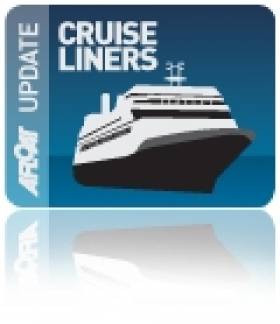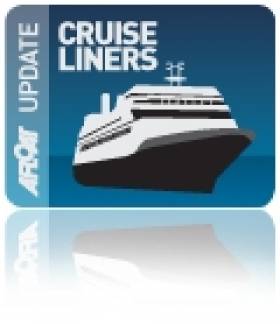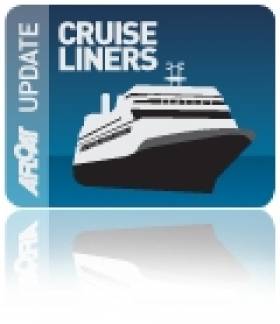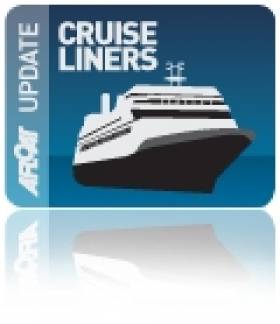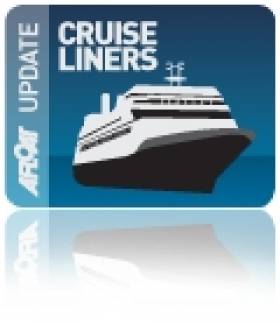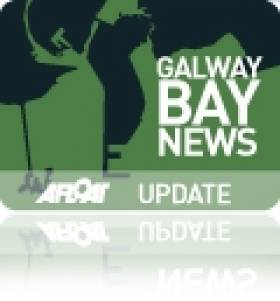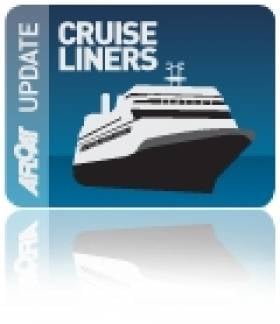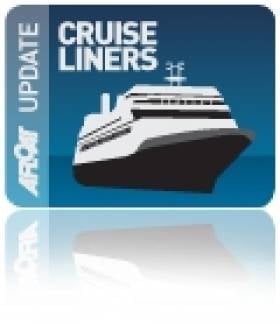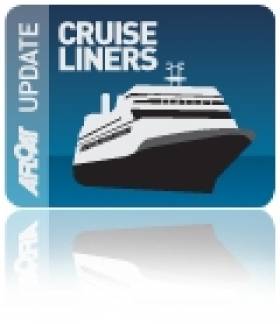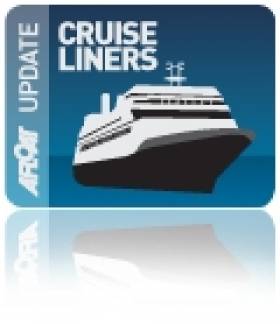Displaying items by tag: Cruise Liners
A Classic Double Act: From General Cargoships to Cruise Liners
#CARGO TO CRUISELINERS – This morning saw the arrival of World Cruises Agency,'s Princess Daphne to Dublin Port, the veteran vessel built in 1955 was originally launched as a cargoship, writes Jehan Ashmore.
The 18,833grt cruiseship had arrived into Dublin Bay from Falmouth, however her cruise embarkation port was from Portsmouth, where World Cruises started their inaugural cruise call to Ireland. Yet again another newcomer operating in Irish waters this season.
In recent years Princess Daphne and her sister Princess Danae, have operated for Classic Cruises International (CIC), and they were among a fleet of older tonnage.
Before she became Princess Daphne, she was commissioned for Port Line (subsidiary of Cunard Line) and was built at the shipyard of Swan Hunter on Newcastle-upon-Tyne and launched as Port Sydney. She was joined by her sister Port Melbourne, also completed in the same year but built by Harland & Wolff. They were ordered to serve the UK route to New Zealand, Australia via the Panama Canal.
The handsome looking general cargoships or 'reefers' (handling meat exports) had a large superstructure, with accommodation for 12 passengers. Noting the wraparound passenger veranda deck and six cargo-holds accompanied by derricks for self-unloading.
Conversion work took place in 1975 and again this applied to her sister the following year. The rebuild included replacing the old superstructure with a large longer streamlined superstructure, noting fore-ward of the bridge are the derricks that was incorporated during the work. This feature does not apply to Princess Danae which has an extended structure instead.
They retain their have deep-drafted (7.9m) hulls, complete with many portholes along sheer classic lines. Princess Daphne has a hull length of 162.39m which is marginally longer then her sister's 162.31m.
Over their respective career spanning nearly six decades, they have operated for several owners and under different names, however their current names have remained for some time. The pair are both Portuguese flagged and operated by World Cruises based in Lisbon.
Incidentally Princess Danae (1955/16,531grt) will be making a call to Dublin Port tomorrow, as she is scheduled to arrive at her birthplace in Belfast Harbour today. Also in port, is Plantours & Partners Cruises Hamburg, which had sailed overnight from Dublin Port, as previously reported on Afloat.ie.
Plantours Cruises Hamburg Makes Maiden 'Irish' Call
#CAPITAL CRUISE CALLS – Tonight two cruiseships are due to depart Dublin Port, they are Plantours Cruises Hamburg (2007/15,067grt), which made its maiden 'Irish' debut call to the capital, followed by Compagnie du Ponant's Le Diamant, writes Jehan Ashmore.
Plantours is a German based operator and is one of several new entrants providing cruises to Irish ports, as previously reported on Afloat.ie. Among the newcomers are MSC Cruises, whose MSC Lirica finally made her first call to Cobh at the weekend, as an earlier scheduled call this month, was cancelled due to bad weather.
Both the visiting vessels to Dublin Port today, had by coincidence arrived from Penzance, Cornwall and the Hamburg, is no stranger to the capital, having previously operated as Hapag-Lloyd's C. Columbus.
Whereas the French operated Le Diamant (1974/8,282grt) has been in Irish waters throughout this month, with a call to Galway on 17th August. On the same day Voyages of Discovery, which is part of the All Leisure Group, saw their Discovery also make an anchorage call of the mid-western port.
'Floating Campus' MV Explorer to Visit Galway This Friday
#CRUISE LINERS - Galway Bay is set to welcome a visit from the 'floating campus' MV Explorer this Friday 21 August, as the Galway Independent reports.
The cruise liner, with more than 800 students, academics and crew on board, operates as part of the Semester at Sea study abroad programme which invites students from 25 universities across the Unites States to travel the world and experience its diversity.
PhD student Sarah Cosgrove of NUI Galway's Ryan Institute for marine science - who joined the cruise at its last port of call in Halifax, Nova Scotia - will talk to the visiting students about Galway, its port and the university.
At 590 feet in length, the 10-year-old vessek is too large to enter Galway Harbour so will instead drop anchor out in Galway Bay.
Its arrival follows that of two other liners, Le Diamant and the Discovery, that arrived in Galway in Friday 17 August with 1,400 passengers and crew between them. Both are set to return to the City of the Tribes next month.
The Galway Independent has much more on the story HERE.
Lirica's Call Again Brings ‘Added Value’ to the Capital
#LIRICA CALLS AGAIN – Only on her second cruise call to Dublin Port, MSC Lirica (2003/59,058grt) as previously reported on Afloat.ie, docked this morning into the capital brimming with tallships, adding another attraction for cruise-goers, writes Jehan Ashmore.
The $250m ship, made her maiden call to Ireland just over a fortnight ago with over 3,000 passengers. The 251m long vessel operated by Mediterranean Shipping Company (MSC) Cruises, which is the newest company to enter the Irish market and in total there are 90 callers to Dublin Port in 2012.
In May next year the port is to welcome another MSC Cruises vessel with the larger 293m MSC Magnifica, which cost $547million and was only completed in 2010.
The value of the sector is estimated to generate €35 and €50 million for the local economy, bringing over 100,000 high-spend passengers and crew to the city and surrounding areas' shops, attractions and eateries each year.
Add to that, an estimated 1 million visitors over the four-day Tall Ships festival, not to mention the international crew of 1,500 and attendant publicity. Albeit the tallships festival in Dublin is an infrequent event as it was held in the capital in 1998.
However this is the opposite with the expanding cruise business sector, where increasingly larger liners are making more regular calls. In order to cope with capacity the Dublin Port Company's Masterplan 2012-2040 has proposed a new €110m cruise terminal identified beside the East Link toll-lift bridge, recent witness to the numerous tallships passing through.
On a nationwide basis, over the last two years, it has been estimated that the cruise ship industry has contributed €20.3 million. Noting many cruise-callers make visits to more than one Irish port, particularly those calling to the premier ports, where economic opportunities for the hinterland's could be worth a potential €60 million over the next few years.
The Swiss headquartered MSC group don't just operate cruiseships, and are not new to Ireland, as for several years through their global container shipping division, its operation here, MSC (Ireland) started providing direct container shipping routes.
Initially they used their own tonnage (later chartered vessels) from one of the world's largest containership fleets, where the MSC compass brand symbol can be seen on the mixed fleet but also on the containers themselves.
Strong First Half 2012 Cruise Call Season to Ireland
#CRUISE LINERS – According to the Irish Maritime Development Office (IMDO), a number of calls by international cruise ships to Irish ports, many on their maiden calls to this country, have visited within the first half of 2012.
Irish Ports had confirmed visits for 202 international cruise liners this year and so far they have welcomed a broad collection of vessels including Princess Cruises 'Grand' class liner Grand Princess in January which lead to the disembarkation of an estimated 4,000 visitors to Dublin Port.
Also calling to the capital as previously reported was the $250m luxury cruise liner MSC Lirica carrying almost 3,000 passengers and Cobh during the month of August. She is due to make a repeat call to both ports this weekend, firstly to the capital and then sailing overnight to Cobh.
Over the past two years, it has been estimated that the cruise ship industry has contributed €20.3 million to the island of Ireland.
With the increase in bigger liner ships calling to this country there are clear indications that the contribution that the cruise industry is making to the Irish economy will have a significant influence on the economic opportunities for the hinterland's of Irish host ports, and could be worth a potential €60 million over the next few years.
Most recently, at the Cruise Europe Conference 2012 held at Royal Greenwich, London, Captain Michael McCarthy of the Port of Cork, was unanimously elected Chairman of Cruise Europe. Captain McCarthy is currently serving as Commercial Manager with the Port of Cork Company.
Commenting on the Irish cruise business, the newly elected chairman of Cruise Europe, Captain Michael McCarthy said: "There are many indirect economic and tourism benefits to Ireland from the cruise sector, as well as the benefit of introducing Ireland to new markets and growing business opportunities. Cruise visits help to showcase Ireland's world class shore products, destinations and highlight all that Ireland has to offer visitors."
He continued: "One of Ireland's advantages is the strategic and geographic spread of its numerous ports, many of which are in close proximity to world class tourism destinations and it is with this in mind that Ireland will be promoted with the North and Atlantic European destinations to develop thriving and 'must see' destinations".
New Galway Port Development Plans Revived
#GALWAY HARBOUR - Plans for a €200 million deepwater port in Galway Harbour have been revived, according to The Irish Times, as harbour bosses seek to exercise a clause in the EU habitats directive.
As previously reported on Afloat.ie, plans for the port were withdrawn after the failure of the Galway Harbour Company to secure the necessary approvals for preliminary site investigation works.
The original development proposed transferring port operations from the existing single-dock facility south into Galway Bay, where reclaimed land in deeper waters would accommodate larger cruise liners as well as a freight rail link and a 200-berth marina.
Galway Harbour Company chief executive Eamon Bradshaw said the company was now taking a new route after examining previous planning applications involving sensitive habitats.
He pointed out that under article 6.4 of the EU habitats directive, applications for projects classified under “imperative reasons for overriding public interest” allow developers to compensate for any infringement on senstive habitats by restoring an area of a similar size in a different location.
Bradshaw added that consultations are under way with An Bord Pleanála and other State agencies.
P&O Cruises Adonia Calls to Foynes
#SHANNON CRUISECALL – P&O Cruises Adonia is visiting the mid-west port of Foynes on the banks of the Shannon port today, writes Jehan Ashmore.
She had made a call to the east coast last week in Dublin Port and the 30,277 tonnes vessel is the second caller so far this year to visit the Shannon region, when the ultra-luxurious Silver Whisper docked in the Co. Limerick port in mid-May.
A further two cruise callers are scheduled, as Le Diamant is also due to call this week on Thursday. The final caller is Amadea, which is expected to close the season next month.
All cruise callers will dock in Foynes which is one of six port facilities along the Shannon Estuary which is under the control of the Shannon Foynes Port Company (SFPC).
Cruise Liner Treesome Arrive into Foggy Dublin Bay
#CRUISE LINERS – In dense sea-fog conditions, three cruiseships arrived into Dublin Bay at dawn and proceeded to dock in Dublin Port, writes Jehan Ashmore.
Of the trio, Kristina Katarina (1982/12,668grt) today made her inaugural call to the port. As previously reported on Afloat.ie she is operated by Finnish owners Kristina Cruises based in Kotka, a city midway between Helsinki and sharing the border with the Russian Federation.
The other vessels, P&O Cruises Adonia (2001/30,277grt) and Silverseas Cruises Cloud (1994/16,927grt) are berthed within Alexandra Basin, nearby Kristina Katarina is moored on the river berth at Ocean Pier.
Reported last month another tree-some of cruiseships gathered in the port, which this year is scheduled to see around 90 such cruise callers during the season.
Academic Arrangements at Sea
#CRUISE LINERS - New York based Academic Arrangements Abroad have chartered Zegraham Expeditions Clipper Odyssey which is to call to Belfast Harbour today for an overnight visit, writes Jehan Ashmore.
Academic Arrangements offer more than 50 countries for guests to go cruising and accompanied by renowned scholars on itineraries specific to the nation's visited with tours to pre-eminent museums and alumni associations.
The tours also take a look behind the scenes of major cultural institutions and privileged access to private art collections and impressive gardens.
Guests on-board the 110-passenger adventure-style ship, are accommodated in 64 outside cabins. They have a sitting area with sofa, flat-screen TV and an individually controlled thermostat. Larger sized cabins (beds arranged in twins or queen) are located on Bridge Deck and some have balconies.
Asides fine dining facilities, passengers can avail of amenities including an outdoor pool, gym and library. On the technology front, computers with internet access and Wi-Fi are provided in public areas.
As to be expected of the adventure-cruiseship, a fleet of boats (note Zodiacs on top deck) which allow passengers to access more isolated destinations and the ability to get closer to wildlife and nature.
During her Irish Sea cruising grounds this month, the vessel is scheduled to return to Belfast twice. To view other cruise callers click the LIST.
Cunard Line's Newest Cruiseship to Revisit
#CUNARDER REVISIT – Since her launch in 2010, Cunard Line's newest cruiseship the 90,901 tonnes Queen Elizabeth has only called to Dublin Port once and that was last year. She was then on her maiden 'Irish' port of call and the 2068 passenger vessel is to return on Saturday, writes Jehan Ashmore.

Joining her on the schedule of visiting cruiseships this August, which not surprisingly is the busiest period of the high-season, will be Holland America Line's Maasdam. She is to arrive only an hour later that morning.
The month is scheduled to see 28 cruise callers (list) in total, the first caller having already arrived yesterday with the Hebridean Princess staying overnight in the port.
Following the Cunarder's call she will her head overnight bound for Cobh Cruise Terminal, where the Italian built vessel also made an inaugural port of call (list) in 2011.


























